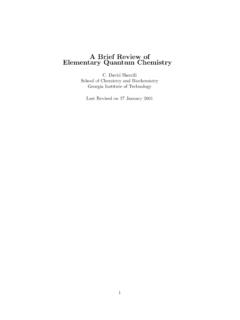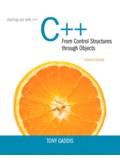Transcription of Program Organization - Georgia Institute of …
1 CWCS Workshop May 2005. Programming Basics - FORTRAN 77. ~bowman/PHY520/F77 Program Organization A FORTRAN Program is just a sequence of lines of plain text. This is called the source code. The text has to follow certain rules (syntax) to be a valid FORTRAN Program . We start by looking at a simple example: Program circle real r, area, pi c This Program reads a real number r and prints c the area of a circle with radius r. write (*,*) 'Give radius r:'. read (*,*) r pi = atan( )* area = pi*r*r write (*,*) 'Area = ', area end A FORTRAN Program generally consists of a main Program and possibly several subprograms ( , functions or subroutines). The structure of a main Program is: Program name declarations statements end Note: Words that are in italics should not be taken as literal text, but rather as a description of what belongs in their place.
2 FORTRAN is not case-sensitive, so "X" and "x" are the same variable. Blank spaces are ignored in Fortran 77. If you remove all blanks in a Fortran 77 Program , the Program is still acceptable to a compiler but almost unreadable to humans. Column position rules Fortran 77 is not a free-format language, but has a very strict set of rules for how the source code should be formatted. The most important rules are the column position rules: Col. 1: Blank, or a "c" or "*" for comments Col. 1-5: Blank or statement label Col. 6: Blank or a "+" for continuation of previous line Col. 7-72: Statements Comments The lines that begin with a "c" or "*" are comments and have no purpose other than to make the Program more readable for humans. Continuation Sometimes, a statement does not fit into the 66 available columns of a single line.
3 One can then break the statement into two or more lines, and use the continuation mark in position 6. Example: c The next statement goes over two physical lines area = + * r * r Any character can be used instead of the plus sign as a continuation character. It is considered good programming style to use either the plus sign or digits (using 2 for the second line, 3 for the third, and so on). Declarations Every variable should be defined in a declaration. This establishes the type of the variable. The most common declarations are: integer list of variables real list of variables logical list of variables character list of variables The list of variables should consist of variable names separated by commas. Each variable should be declared exactly once. The parameter statement Some constants appear many times in a Program .
4 It is then often desirable to define them only once, in the beginning of the Program . This is what the parameter statement is for. It also makes programs more readable. For example, the circle area Program should rather have been written like this: Program circle real r, area, pi parameter (pi = ). c This Program reads a real number r and prints c the area of a circle with radius r. write (*,*) 'Give radius r:'. read (*,*) r area = pi*r*r write (*,*) 'Area = ', area end The syntax of the parameter statement is parameter (name = constant, .. , name = constant). Assignment A variable assignment has the form: variable_name = expression The interpretation is as follows: Evaluate the right hand side and assign the resulting value to the variable on the left. The expression on the right may contain other variables, but the variable assignment does not change their value.
5 The following example does not change the value of pi or r, only area: area = pi*r*r Logical expressions Logical expressions can only have the value .TRUE. or .FALSE. A logical expression can be formed by comparing arithmetic expressions using the following relational operators: .LT. meaning <..LE. <=..GT. >..GE. >=..EQ. =..NE. /=. The if statement An important part of any programming language is the conditional statements. The most common such statement in FORTRAN is the if statement. The following is a simple example of the logical if statement that finds the absolute value of x: if (x .LT. 0) x = -x The most general form of the if statement has the following form: if (logical expression) then statements elseif (logical expression) then statements : : else statements endif The execution flow is from top to bottom.
6 The conditional expressions are evaluated in sequence until one is found to be true. Then the associated statements are executed and the control resumes after the endif. loops For repeated execution of similar things, loops are used. The do-loop is used for simple counting. Here is a simple example that prints the cumulative sums of the integers 1 through 10: integer i, n, sum sum = 0. n = 10. do i = 1, n sum = sum + i write(*,*) 'i =', i write(*,*) 'sum =', sum enddo The number 10 is a statement label. Typically, there will be many loops and other statements in a single Program that require a statement label. The programmer is responsible for assigning a unique number to each label in each Program (or subprogram). Recall that column positions 1-5 are reserved for statement labels. The numerical value of statement labels has no significance, so any integers can be used, in any order.
7 Typically, most programmers use consecutive multiples of 10. Arrays Many scientific computations use vectors and matrices. The data type FORTRAN uses for representing such objects is the array. A one-dimensional array corresponds to a vector, while a two-dimensional array corresponds to a matrix. The simplest array is the one-dimensional array, which is just a sequence of elements stored consecutively in memory. For example, the declaration real vect1(20). declares vect1 as a real array of length 20. By convention, FORTRAN arrays are indexed from 1 and up. Thus the first number in the array is denoted by vect1(1) and the last by vect1(20). However, you may define an arbitrary index range for your arrays using the following syntax: real b(0:19), weird(-162:237). Here, b is similar to vect1 from the previous example, except the index runs from 0 through 19, while weird is an array of length 237-(-162)+1 = 400.
8 Each element of an array can be thought of as a separate variable. You reference the i'th element of array a by a(i). Here is a code segment that stores the squares of the numbers 1. through 10 in the array sq: integer i, sq(10). do i = 1, 10. sq(i) = i**2. enddo A common bug in Fortran is that the Program tries to access array elements that are out of bounds or undefined. This is the responsibility of the programmer, and the Fortran compiler will not detect any such bugs! Matrices are very important in linear algebra. Matrices are usually represented by two-dimensional arrays. For example, the declaration real A(3,5). defines a two-dimensional array of 3*5=15 real numbers. It is useful to think of the first index as the row index, and the second as the column index. Hence we get the graphical picture: (1,1) (1,2) (1,3) (1,4) (1,5).
9 (2,1) (2,2) (2,3) (2,4) (2,5). (3,1) (3,2) (3,3) (3,4) (3,5). It is quite common in Fortran to declare arrays that are larger than the matrix we want to store. (This is because Fortran does not have dynamic storage allocation.) This is perfectly legal. Example: real A(3,5). integer i,j c c We will only use the upper 3 by 3 part of this array. c do j = 1, 3. do i = 1, 3. A(i,j) = real(i)/real(j). enddo enddo The elements in the submatrix A(1:3,4:5) are undefined. Do not assume these elements are initialized to zero by the compiler (some compilers will do this, but not all). Functions FORTRAN functions are quite similar to mathematical functions. They both take a set of input arguments (variables) and return a value of some type. Fortran 77 has some intrinsic (built-in) functions. The following example illustrates how to use a function: x = cos( ).
10 Here cos is the cosine function, so x will be assigned the value assuming pi has been correctly defined; Fortran 77 has no built-in constants. There are many intrinsic functions in Fortran 77. Some of the most common are: abs absolute value sqrt square root sin sine tan tangent atan arctangent exp exponential (natural). log logarithm (natural). Input/Output An important part of any computer Program is the handling of input and output. In our examples so far, we have already used the two most common Fortran constructs for this: read and write. Fortran I/O can be quite complicated, so we will only describe some simpler cases in this handout. Read is used for input, while write is used for output. A simple form is read (unit no, format no) list-of-variables write(unit no, format no) list-of-variables The unit number can refer to either standard input, standard output, or a file.
















